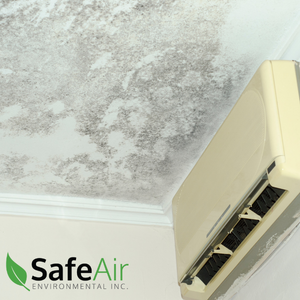The Connection Between Indoor Air Quality and Mold
Posted in Air Quality, on February 15, 2022
 Mold is a common problem in homes, but it’s usually thought about more in terms of physical damage than its effect on your indoor air environment. However, mold spores are one of the most frequently detected particles during home air quality testing in Toronto, which makes mold’s effect not only limited only to the visual and physical damage on your home, but to your respiratory and bodily health as well. SafeAir’s comprehensive indoor air quality inspection services detect mold and other common indoor allergens so that you’re not left guessing — and that you don’t miss anything.
Mold is a common problem in homes, but it’s usually thought about more in terms of physical damage than its effect on your indoor air environment. However, mold spores are one of the most frequently detected particles during home air quality testing in Toronto, which makes mold’s effect not only limited only to the visual and physical damage on your home, but to your respiratory and bodily health as well. SafeAir’s comprehensive indoor air quality inspection services detect mold and other common indoor allergens so that you’re not left guessing — and that you don’t miss anything.
What is Indoor Air Pollution?
We all know what pollution is when it comes to the world around us, but indoor pollution is harder to define. Many homeowners guess that dust and dander have something to do with it, but that’s not the whole story. There are hundreds, if not thousands, of different allergens, particles, chemicals, gases and more that can affect the indoor air quality of your home.
These particles exist outside, too; it’s just that there are also forces like wind and weather that are moving them around and away. Indoors, these particles can become concentrated, which is when they begin to affect our homes and our bodies negatively.
Humidity Vs Mold Growth
Mold is a natural part of the world and is a vital part of biological decay. Ideally, our homes are hostile to mold growth, which needs a stable temperature and moisture to grow, but in practice, our homes and habits make it very easy for mold to find a grip.
Humidity is one of the key factors that SafeAir looks at during home air quality testing in Toronto. Balancing indoor moisture can be challenging because it changes with the seasons. High indoor humidity can result in condensation, water pooling, and can transfer moisture from room to room.
Mold always grows where there’s water — when we find mold during our inspections, we always follow it back to its source.
How to Prevent Mold Growth
If you don’t have mold growing in your home, the best thing you can do is implement strategies to prevent it from happening in the future.
While there’s not much you can do when it comes to floods, burst pipes, or other surprises, the SafeAir team generally recommends:
- Balancing your indoor humidity at 40-50%
- Opening the window when having a hot and steamy shower
- Installing an exhaust fan in the kitchen or bathroom
- Make sure windows have tight-fitting seals
- Providing ventilation to spaces without air movement, like the basement.
- Installing a dehumidifier, if necessary
Of course, we think that having an indoor air quality inspection is an excellent part of mold prevention too! Not only can we detect hidden mold colonies inside walls or underneath heavy furniture, but SafeAir’s testing protocol also looks at humidity, environmental factors, and architectural factors that may promote mold growth. We can do specific tests for mold, but our general indoor air quality testing will detect issues like mold, asbestos, lead, dust, VOCs, and other common indoor air quality pollutants.
Avoid Mold with Regular Testing
When it comes to indoor air quality, the various elements of your home all interact to create ideal conditions for mold growth as well as other problematic and dangerous side effects. While we’ve discussed the link between humidity and mold growth here, many other air quality issues may be affected or caused by either of these two factors.
Mold can cause structural damage and damaging health effects in both the short and long term, so it needs to be taken seriously as a regular part of home maintenance. If you have any concerns about how home air quality testing in Toronto can help, reach out to the SafeAir team to learn about our process — we’d love to help you breathe easier and safer at home.

